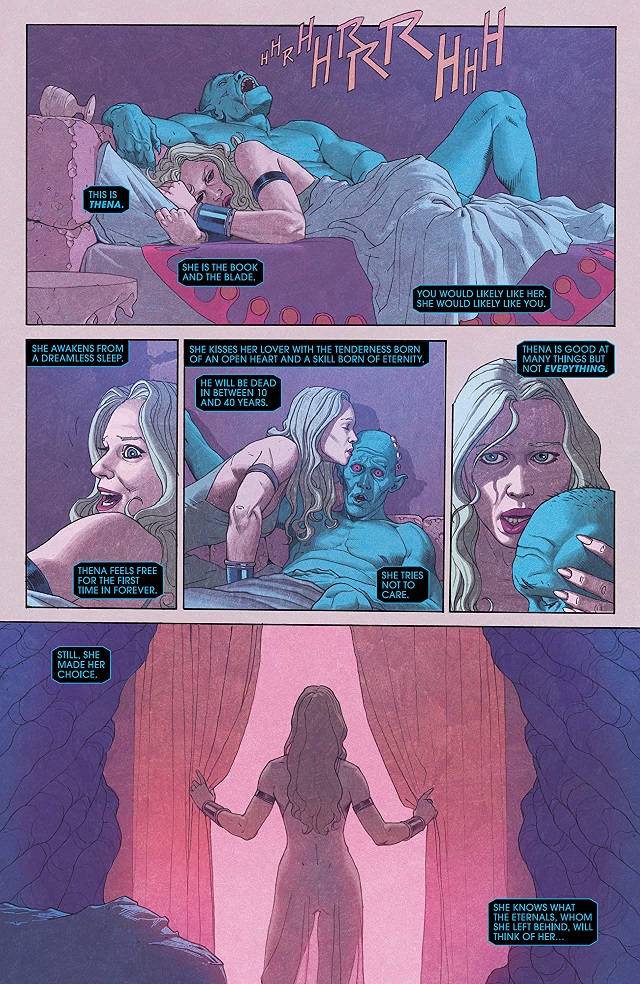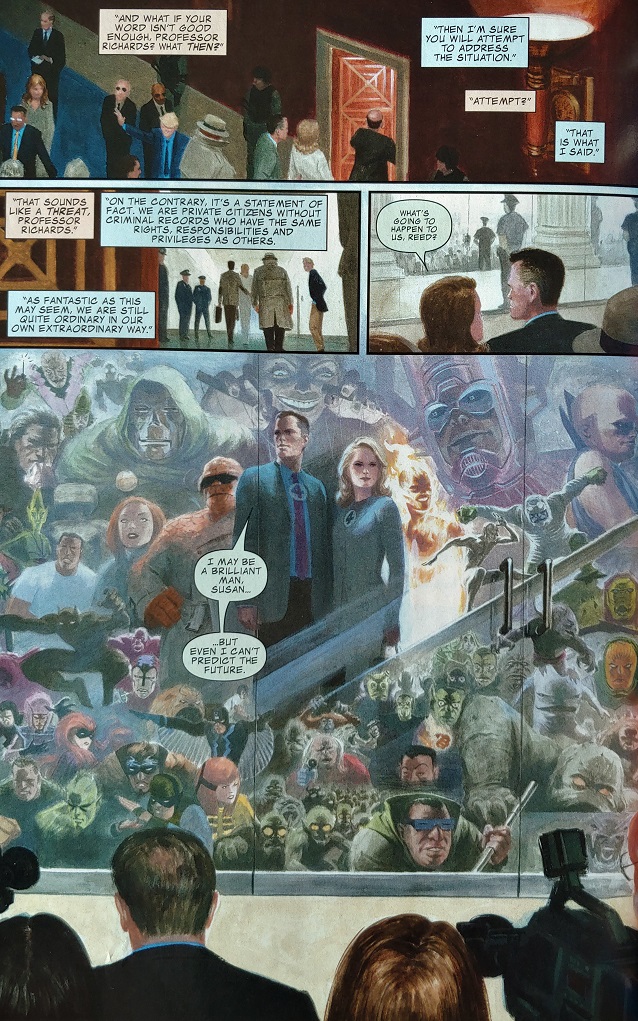Of course we know that Jack Kirby was the artist responsible for the creation of Captain America, Thor, Iron Man, Hulk, the X-Men, the Fantastic Four and basically almost the entire Marvel Universe. However, in all of these situations he was working with a writer, either Joe Simon or Stan Lee. It wasn’t until when he was finally allowed to write and draw his own stories, and the result was New Gods for DC Comics and the Eternals for Marvel. Kirby also introduced the Celestials, who created both the Eternals and the Deviants.
In the third chapter of “Only Death is Eternal” (originally published in Eternals # 3, May 2021), Thena, described as “a goddess in Hell”, wakes up next to her lover, a Deviant, in the city of Lemuria. An invincible warrior, Thena also seems to have an insatiable appetite for sexual encounters, and she always prefer different species, so instead of turning to her fellow Eternals, she’d rather mingle with humans or Deviants or what have you. Esad Ribić’s design of Lemuria seems to come from our dreams, but it also seems to come from our past. Lemuria is a combination of how we imagine mythical cities like Atlantis, that belong to the past, and how we dream about new and fantastic cities. With an extraordinary splash page, Ribić shows us how impressive Lemuria is.
 |
| Esad Ribic |
It’s also in this third chapter that we see Toby Robson, an ordinary teenager that has been deemed worthy of Ikaris’s attention. According to the Eternal, Toby might die soon, but that won’t happen if Ikaris offers to protect him. Ikaris also enlists Sprite as Toby’s personal bodyguard. In a casual conversation between the Eternal and the parents, the idea of Ikaris simply being present there is what might actually endanger Toby is something that will pay off in the end of the miniseries, but not in the usual way of a villain attacking a hero, and civilians getting hurt in the process. Finally, we get to see the interactions between Thena and Sersi.
 |
| Thena |
As powerful as the interior art is, the painted covers by Ribić are even more exquisite. The cover for issue # 3 presents a magnificent composition, with Sprite, Thena and Sersi looking at us with determination, while Thena’s frightened deviant lover absconds, almost camouflaging in the background, which is the mythic city of Lemuria. The cover for issue # 4 is also a fine example of design, balance and proportions; beautifully executed and with a special eye for details, once again Ribić proves to be an amazing artist.
 |
| Lemuria |
In the fourth chapter of “Only Death is Eternal” (Eternals # 4, June 2021) we appreciate even more the scope of Gillen’s intentions as a writer, and especially his impressive world-building abilities. In addition to the main storyline, Gillen is providing us, the readers, with a lot of information about the different groups of Eternals, their cities, their past and so on. Here we also see Phastos attempting to repair the Celestial machine, the one that has existed for millennia and that is responsible for the resurrection of the Eternals.
 |
| Ikaris & Toby Robson |
Of course, one of my favorite moments is the one in which we see Sprite taking the school bus with Toby Robson. The two of them talk, and as a way of reassuring Toby that he is well protected, Sprite points out to the sky; and in a magnificent panel we see Ikaris hovering over the city. But what is so special about this boy that requires the protection of not one but two of the most powerful Eternals? That question will be answered in the final issue of this story-arc.
________________________________________________________________________________________________________
________________________________________________________________________________________________________
Por supuesto, sabemos que Jack Kirby fue el artista responsable de la creación del Capitán América, Thor, Iron Man, Hulk, los X-Men, los Cuatro Fantásticos y básicamente casi todo el Universo Marvel. Sin embargo, en todas estas situaciones estaba trabajando con un escritor, ya sea Joe Simon o Stan Lee. No fue hasta que finalmente se le permitió escribir y dibujar sus propias historias, que los resultados fueron los New Gods para DC Comics y los Eternals para Marvel. Kirby también introdujo a los Celestiales, quienes crearon tanto a los Eternos como a los Desviantes.
 |
| Sersi & Thena |
En el tercer capítulo de “Sólo la muerte es eterna” (publicado originalmente en Eternals # 3, mayo del 2021), Thena, descrita como "una diosa en el infierno", se despierta junto a su amante, un desviante, en la ciudad de Lemuria. Una guerrera invencible, Thena también parece tener un apetito insaciable por los encuentros sexuales, y siempre prefiere especies diferentes, por lo que en lugar de recurrir a sus compañeros Eternos, prefiere mezclarse con humanos o desviantes o lo que encuentro por el camino. El diseño de Esad Ribić de Lemuria parece provenir de nuestros sueños, pero también parece provenir de nuestro pasado. Lemuria es una combinación de cómo imaginamos ciudades míticas como la Atlántida, que pertenecen al pasado, y cómo soñamos con ciudades nuevas y fantásticas. Con una página completa extraordinaria, Ribić nos muestra lo impresionante que es Lemuria.
 |
| deviants / desviantes |
También es en este tercer capítulo donde vemos a Toby Robson, un adolescente común y corriente que ha sido considerado digno de la atención de Ikaris. Según el Eterno, Toby podría morir pronto, pero eso no sucederá si Ikaris le ofrece protegerlo. Ikaris también recluta a Sprite como guardaespaldas personal de Toby. En una conversación casual entre el Eterno y los padres, la idea de que Ikaris simplemente esté presente allí es lo que realmente podría poner en peligro a Toby; algo que dará frutos al final de la miniserie, pero no de la forma habitual en la que un villano ataca a un héroe y los civiles resultan heridos en el proceso. Finalmente, podemos ver las interacciones entre Thena y Sersi.
 |
| Druig |
Por poderoso que sea el arte interior, las portadas pintadas a mano por Ribić son aún más exquisitas. La portada del número 3 presenta una composición magnífica, con Sprite, Thena y Sersi mirándonos con determinación, mientras el asustado amante desviante de Thena se escapa, casi camuflándose en el fondo, que es la mítica ciudad de Lemuria. La portada del número 4 también es un buen ejemplo de diseño, equilibrio y proporciones; bellamente ejecutada, y con un ojo especial para los detalles, una vez más Ribić demuestra ser un artista increíble.
 |
| Phastos |
En el cuarto capítulo de “Sólo la muerte es eterna” (Eternals # 4, junio del 2021) apreciamos aún más el alcance de las intenciones de Gillen como escritor, y especialmente sus impresionantes habilidades para construir mundos. Además de la historia principal, Gillen nos proporciona a nosotros, los lectores, mucha información sobre los diferentes grupos de Eternals, sus ciudades, su pasado, etc. Aquí también vemos a Phastos intentando reparar la máquina Celestial, la que existe desde hace milenios y que es responsable de la resurrección de los Eternos.
 |
| Toby Robson, Sprite & Ikaris |
Por supuesto, uno de mis momentos favoritos es aquel en el que vemos a Sprite tomando el autobús escolar con Toby Robson. Los dos hablan, y como una forma de asegurarle a Toby que está bien protegido, Sprite señala al cielo; y en una magnífica viñeta vemos a Ikaris sobrevolando la ciudad. Pero, ¿qué tiene de especial este chico que requiere la protección no de uno sino de dos de los Eternos más poderosos? Esa pregunta será respondida en el número final de este arco argumental.

























